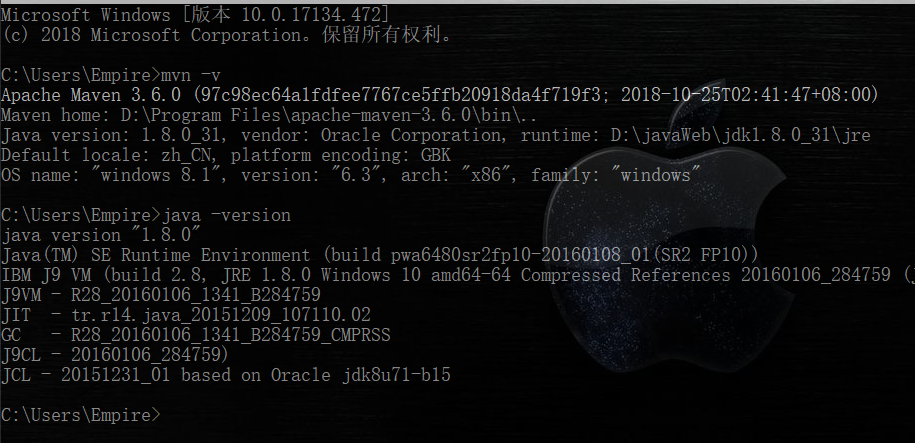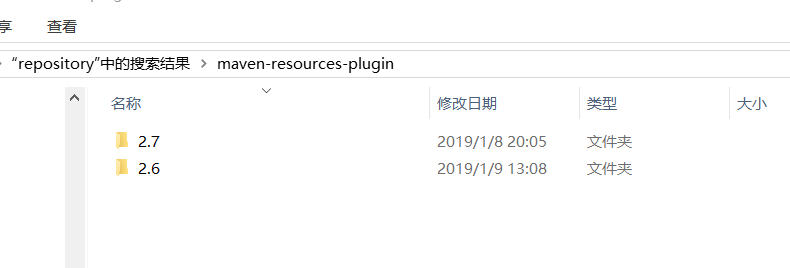Maven-环境配置
=================================================二更================================================================
可算搞好了,除了下面外,我找到了setting.xml里面的东西,给出来就好了,简单就是mvn -v弄好后,setting.xml里面写好的话,直接加入,然后让eclipse下载jar包
然后就可以运行网上的基本项目了

1 <?xml version="1.0" encoding="UTF-8"?> 2 3 <!-- 4 Licensed to the Apache Software Foundation (ASF) under one 5 or more contributor license agreements. See the NOTICE file 6 distributed with this work for additional information 7 regarding copyright ownership. The ASF licenses this file 8 to you under the Apache License, Version 2.0 (the 9 "License"); you may not use this file except in compliance 10 with the License. You may obtain a copy of the License at 11 12 http://www.apache.org/licenses/LICENSE-2.0 13 14 Unless required by applicable law or agreed to in writing, 15 software distributed under the License is distributed on an 16 "AS IS" BASIS, WITHOUT WARRANTIES OR CONDITIONS OF ANY 17 KIND, either express or implied. See the License for the 18 specific language governing permissions and limitations 19 under the License. 20 --> 21 22 <!-- 23 | This is the configuration file for Maven. It can be specified at two levels: 24 | 25 | 1. User Level. This settings.xml file provides configuration for a single user, 26 | and is normally provided in ${user.home}/.m2/settings.xml. 27 | 28 | NOTE: This location can be overridden with the CLI option: 29 | 30 | -s /path/to/user/settings.xml 31 | 32 | 2. Global Level. This settings.xml file provides configuration for all Maven 33 | users on a machine (assuming they're all using the same Maven 34 | installation). It's normally provided in 35 | ${maven.conf}/settings.xml. 36 | 37 | NOTE: This location can be overridden with the CLI option: 38 | 39 | -gs /path/to/global/settings.xml 40 | 41 | The sections in this sample file are intended to give you a running start at 42 | getting the most out of your Maven installation. Where appropriate, the default 43 | values (values used when the setting is not specified) are provided. 44 | 45 |--> 46 <settings xmlns="http://maven.apache.org/SETTINGS/1.0.0" 47 xmlns:xsi="http://www.w3.org/2001/XMLSchema-instance" 48 xsi:schemaLocation="http://maven.apache.org/SETTINGS/1.0.0 http://maven.apache.org/xsd/settings-1.0.0.xsd"> 49 <!-- localRepository 50 | The path to the local repository maven will use to store artifacts. 51 | 52 | Default: ${user.home}/.m2/repository 53 --> 54 <localRepository>E:\m2\repository</localRepository> 55 56 57 <!-- interactiveMode 58 | This will determine whether maven prompts you when it needs input. If set to false, 59 | maven will use a sensible default value, perhaps based on some other setting, for 60 | the parameter in question. 61 | 62 | Default: true 63 <interactiveMode>true</interactiveMode> 64 --> 65 66 <!-- offline 67 | Determines whether maven should attempt to connect to the network when executing a build. 68 | This will have an effect on artifact downloads, artifact deployment, and others. 69 | 70 | Default: false 71 <offline>false</offline> 72 --> 73 74 <!-- pluginGroups 75 | This is a list of additional group identifiers that will be searched when resolving plugins by their prefix, i.e. 76 | when invoking a command line like "mvn prefix:goal". Maven will automatically add the group identifiers 77 | "org.apache.maven.plugins" and "org.codehaus.mojo" if these are not already contained in the list. 78 |--> 79 <pluginGroups> 80 <!-- pluginGroup 81 | Specifies a further group identifier to use for plugin lookup. 82 <pluginGroup>com.your.plugins</pluginGroup> 83 --> 84 </pluginGroups> 85 86 <!-- proxies 87 | This is a list of proxies which can be used on this machine to connect to the network. 88 | Unless otherwise specified (by system property or command-line switch), the first proxy 89 | specification in this list marked as active will be used. 90 |--> 91 <proxies> 92 <!-- proxy 93 | Specification for one proxy, to be used in connecting to the network. 94 | 95 <proxy> 96 <id>optional</id> 97 <active>true</active> 98 <protocol>http</protocol> 99 <username>proxyuser</username> 100 <password>proxypass</password> 101 <host>proxy.host.net</host> 102 <port>80</port> 103 <nonProxyHosts>local.net|some.host.com</nonProxyHosts> 104 </proxy> 105 --> 106 </proxies> 107 108 <!-- servers 109 | This is a list of authentication profiles, keyed by the server-id used within the system. 110 | Authentication profiles can be used whenever maven must make a connection to a remote server. 111 |--> 112 <servers> 113 <!-- server 114 | Specifies the authentication information to use when connecting to a particular server, identified by 115 | a unique name within the system (referred to by the 'id' attribute below). 116 | 117 | NOTE: You should either specify username/password OR privateKey/passphrase, since these pairings are 118 | used together. 119 | 120 <server> 121 <id>deploymentRepo</id> 122 <username>repouser</username> 123 <password>repopwd</password> 124 </server> 125 --> 126 127 <!-- Another sample, using keys to authenticate. 128 <server> 129 <id>siteServer</id> 130 <privateKey>/path/to/private/key</privateKey> 131 <passphrase>optional; leave empty if not used.</passphrase> 132 </server> 133 --> 134 </servers> 135 136 <!-- mirrors 137 | This is a list of mirrors to be used in downloading artifacts from remote repositories. 138 | 139 | It works like this: a POM may declare a repository to use in resolving certain artifacts. 140 | However, this repository may have problems with heavy traffic at times, so people have mirrored 141 | it to several places. 142 | 143 | That repository definition will have a unique id, so we can create a mirror reference for that 144 | repository, to be used as an alternate download site. The mirror site will be the preferred 145 | server for that repository. 146 |--> 147 <mirrors> 148 149 <mirror> 150 <id>mirrorId</id> 151 <mirrorOf>repositoryId</mirrorOf> 152 <name>Human Readable Name for this Mirror.</name> 153 <url>http://my.repository.com/repo/path</url> 154 </mirror> 155 <mirror> 156 <!--This sends everything else to /public --> 157 <id>nexus</id> 158 <mirrorOf>*</mirrorOf> 159 <url>http://maven.aliyun.com/nexus/content/groups/public/</url> 160 </mirror> 161 <mirror> 162 <!--This is used to direct the public snapshots repo in the 163 profile below over to a different nexus group --> 164 <id>nexus-public-snapshots</id> 165 <mirrorOf>public-snapshots</mirrorOf> 166 <url>http://maven.aliyun.com/nexus/content/repositories/snapshots/</url> 167 </mirror> 168 </mirrors> 169 170 <!-- profiles 171 | This is a list of profiles which can be activated in a variety of ways, and which can modify 172 | the build process. Profiles provided in the settings.xml are intended to provide local machine- 173 | specific paths and repository locations which allow the build to work in the local environment. 174 | 175 | For example, if you have an integration testing plugin - like cactus - that needs to know where 176 | your Tomcat instance is installed, you can provide a variable here such that the variable is 177 | dereferenced during the build process to configure the cactus plugin. 178 | 179 | As noted above, profiles can be activated in a variety of ways. One way - the activeProfiles 180 | section of this document (settings.xml) - will be discussed later. Another way essentially 181 | relies on the detection of a system property, either matching a particular value for the property, 182 | or merely testing its existence. Profiles can also be activated by JDK version prefix, where a 183 | value of '1.4' might activate a profile when the build is executed on a JDK version of '1.4.2_07'. 184 | Finally, the list of active profiles can be specified directly from the command line. 185 | 186 | NOTE: For profiles defined in the settings.xml, you are restricted to specifying only artifact 187 | repositories, plugin repositories, and free-form properties to be used as configuration 188 | variables for plugins in the POM. 189 | 190 |--> 191 <profiles> 192 <!-- profile 193 | Specifies a set of introductions to the build process, to be activated using one or more of the 194 | mechanisms described above. For inheritance purposes, and to activate profiles via <activatedProfiles/> 195 | or the command line, profiles have to have an ID that is unique. 196 | 197 | An encouraged best practice for profile identification is to use a consistent naming convention 198 | for profiles, such as 'env-dev', 'env-test', 'env-production', 'user-jdcasey', 'user-brett', etc. 199 | This will make it more intuitive to understand what the set of introduced profiles is attempting 200 | to accomplish, particularly when you only have a list of profile id's for debug. 201 | 202 | This profile example uses the JDK version to trigger activation, and provides a JDK-specific repo. 203 <profile> 204 <id>jdk-1.4</id> 205 206 <activation> 207 <jdk>1.4</jdk> 208 </activation> 209 210 <repositories> 211 <repository> 212 <id>jdk14</id> 213 <name>Repository for JDK 1.4 builds</name> 214 <url>http://www.myhost.com/maven/jdk14</url> 215 <layout>default</layout> 216 <snapshotPolicy>always</snapshotPolicy> 217 </repository> 218 </repositories> 219 </profile> 220 --> 221 222 <!-- 223 | Here is another profile, activated by the system property 'target-env' with a value of 'dev', 224 | which provides a specific path to the Tomcat instance. To use this, your plugin configuration 225 | might hypothetically look like: 226 | 227 | ... 228 | <plugin> 229 | <groupId>org.myco.myplugins</groupId> 230 | <artifactId>myplugin</artifactId> 231 | 232 | <configuration> 233 | <tomcatLocation>${tomcatPath}</tomcatLocation> 234 | </configuration> 235 | </plugin> 236 | ... 237 | 238 | NOTE: If you just wanted to inject this configuration whenever someone set 'target-env' to 239 | anything, you could just leave off the <value/> inside the activation-property. 240 | 241 <profile> 242 <id>env-dev</id> 243 244 <activation> 245 <property> 246 <name>target-env</name> 247 <value>dev</value> 248 </property> 249 </activation> 250 251 <properties> 252 <tomcatPath>/path/to/tomcat/instance</tomcatPath> 253 </properties> 254 </profile> 255 --> 256 <profile> 257 <id>jdk-1.8</id> 258 <activation> 259 <activeByDefault>true</activeByDefault> 260 <jdk>1.8</jdk> 261 </activation> 262 <properties> 263 <maven.compiler.source>1.8</maven.compiler.source> 264 <maven.compiler.target>1.8</maven.compiler.target> 265 <maven.compiler.compilerVersion>1.8</maven.compiler.compilerVersion> 266 </properties> 267 </profile> 268 </profiles> 269 270 <!-- activeProfiles 271 | List of profiles that are active for all builds. 272 | 273 <activeProfiles> 274 <activeProfile>alwaysActiveProfile</activeProfile> 275 <activeProfile>anotherAlwaysActiveProfile</activeProfile> 276 </activeProfiles> 277 --> 278 </settings>
当然,如果你用一些什么注释的话,pom.xml里面也要写好,我也给出来吧,基本都可以用,目前用lombok,shiro,thymeleaf什么的都还没遇到错误
也可以映射网页

1 <project xmlns="http://maven.apache.org/POM/4.0.0" xmlns:xsi="http://www.w3.org/2001/XMLSchema-instance" 2 xsi:schemaLocation="http://maven.apache.org/POM/4.0.0 http://maven.apache.org/maven-v4_0_0.xsd"> 3 <modelVersion>4.0.0</modelVersion> 4 <groupId>com.ctgu</groupId> 5 <artifactId>codegroup</artifactId> 6 <packaging>war</packaging> 7 <version>0.0.1-SNAPSHOT</version> 8 <name>codegroup Maven Webapp</name> 9 <url>http://maven.apache.org</url> 10 11 <!-- 12 spring-boot-starter-parent是Spring Boot的核心启动器, 13 包含了自动配置、日志和YAML等大量默认的配置,大大简化了我们的开发。 14 引入之后相关的starter引入就不需要添加version配置, 15 spring boot会自动选择最合适的版本进行添加。 16 --> 17 <parent> 18 <groupId>org.springframework.boot</groupId> 19 <artifactId>spring-boot-starter-parent</artifactId> 20 <version>2.0.0.RELEASE</version> 21 <relativePath/> 22 </parent> 23 24 25 <dependencies> 26 27 <!--Shiro登录界面--> 28 <dependency> 29 <groupId>org.apache.shiro</groupId> 30 <artifactId>shiro-spring</artifactId> 31 <version>1.4.0</version> 32 </dependency> 33 34 35 <!-- Thymeleaf引擎 --> 36 <dependency> 37 <groupId>org.springframework.boot</groupId> 38 <artifactId>spring-boot-starter-thymeleaf</artifactId> 39 </dependency> 40 41 <!-- 热部署所用 --> 42 <dependency> 43 <groupId>org.springframework.boot</groupId> 44 <artifactId>spring-boot-devtools</artifactId> 45 <optional>true</optional> 46 </dependency> 47 48 <!-- 导入jar包所用 --> 49 <dependency> 50 <groupId>org.springframework.boot</groupId> 51 <artifactId>spring-boot-starter-web</artifactId> 52 </dependency> 53 54 55 <dependency> 56 <groupId>junit</groupId> 57 <artifactId>junit</artifactId> 58 <version>3.8.1</version> 59 <scope>test</scope> 60 </dependency> 61 62 <dependency> 63 <groupId>org.apache.maven.plugins</groupId> 64 <artifactId>maven-resources-plugin</artifactId> 65 <version>2.4.3</version> 66 </dependency> 67 68 </dependencies> 69 <build> 70 <finalName>codegroup</finalName> 71 </build> 72 </project>
=====================================================================================================================
前提:简单记录下这2天配置Maven环境遇到的问题
环境:
jdk1.08
Maven3.6.0
eclipse
网上有一大堆讲解,我就不重复了,简单说一下mvn -v弄好后再遇到的问题。
第一步:mvn -v:(验证配置成功入下图)
遇到的第一个问题 (mvn -v一直失败):
解决方案:按道理按照网上步骤不会出错,但是最终发现jdk错误,我之前用的jdk1.6,实际是1.8
下面也又相关视频配置
慕课网 https://www.imooc.com/learn/443
mvn -v成功后打开eclipse中pom.xml一直报错,也明白了maven没有完全配置好。

步骤二:将setting.xml加入路径(如何加入网上也有讲解,如果每次更改setting.xml,除了重新导入setting.xml外,还需要重启eclipse,在Maven Repositories里面的Global Repositories可以检测mirrors是否更新了)

遇到的第二个问题:
CoreException: Could not calculate build plan: Plugin org.apache.maven.plugins:maven-compiler-plugin
解决方案:settings.xml里面profiles没有写好,写好后去你的mirrors里面的repository里面查看jar包,重新下载,具体见如下博客
https://blog.csdn.net/u010452388/article/details/80789816
(我当时是将2.6删除了,然后再建立项目就相当于重新下载,然后就好了)
疑点:settings.xml里面需要修改的就是profiles和mirrors),mirrors按照网上说要改成aliyun或者别的,但是我弄了很多方案也还是Rebuild Index搞不好,不知道为什么,先给出来。


1 <mirror> 2 <id>alimaven</id> 3 <mirrorOf>central</mirrorOf> 4 <name>aliyun maven</name> 5 <url>http://maven.aliyun.com/nexus/content/repositories/central/</url> 6 </mirror> 7 <mirror> 8 <id>alimaven</id> 9 <name>aliyun maven</name> 10 <url>http://maven.aliyun.com/nexus/content/groups/public/</url> 11 <mirrorOf>central</mirrorOf> 12 </mirror> 13 <mirror> 14 <id>central</id> 15 <name>Maven Repository Switchboard</name> 16 <url>http://repo1.maven.org/maven2/</url> 17 <mirrorOf>central</mirrorOf> 18 </mirror> 19 <mirror> 20 <id>repo2</id> 21 <mirrorOf>central</mirrorOf> 22 <name>Human Readable Name for this Mirror.</name> 23 <url>http://repo2.maven.org/maven2/</url> 24 </mirror> 25 <mirror> 26 <id>ibiblio</id> 27 <mirrorOf>central</mirrorOf> 28 <name>Human Readable Name for this Mirror.</name> 29 <url>http://mirrors.ibiblio.org/pub/mirrors/maven2/</url> 30 </mirror> 31 <mirror> 32 <id>jboss-public-repository-group</id> 33 <mirrorOf>central</mirrorOf> 34 <name>JBoss Public Repository Group</name> 35 <url>http://repository.jboss.org/nexus/content/groups/public</url> 36 </mirror> 37 <mirror> 38 <id>google-maven-central</id> 39 <name>Google Maven Central</name> 40 <url>https://maven-central.storage.googleapis.com 41 </url> 42 <mirrorOf>central</mirrorOf> 43 </mirror> 44 <!-- 中央仓库在中国的镜像 --> 45 <mirror> 46 <id>maven.net.cn</id> 47 <name>oneof the central mirrors in china</name> 48 <url>http://maven.net.cn/content/groups/public/</url> 49 <mirrorOf>central</mirrorOf> 50 </mirror> 51 </mirrors>
1 <profiles> 2 3 <profile> 4 <id>jdk-1.8</id> 5 <activation> 6 <activeByDefault>true</activeByDefault> 7 <jdk>1.8</jdk> 8 </activation> 9 <properties> 10 <maven.compiler.source>1.8</maven.compiler.source> 11 <maven.compiler.target>1.8</maven.compiler.target> 12 <maven.compiler.compilerVersion>1.8</maven.compiler.compilerVersion> 13 </properties> 14 </profile> 15 </profiles>
步骤三:继续报错
Could not resolve archetype org.apache.maven.archetypes:maven-archetype-webapp:1.0 from any of the configured repositories.
解决方案:
https://www.cnblogs.com/rever/p/7076596.html
我用的最后一个补充的方法,打开CMD即可,不用在意路径.jar包下载完
步骤四:eclipse不再报错,新建Maven project也不再报错,新建项目如下面博客
https://www.cnblogs.com/lzx2509254166/p/7674455.html
我重新测试了一下,pom.xml里面没更改,什么都没变,一建立就能运行了,eclipse的Console窗口显示如下,建立Maven project即可,什么代码都不用加,然后项目没有红叉叉

总结:总体配置Maven环境过程如下:
1.mvn -v 成功
2.加入setting.xml(里面的东西写好)
3.新建Maven项目不报错(然后就算成功?网上也没看到什么附加内容,就算成功了吧,开始写springbboott项目)
疑点:mirrors那一块我试了各种mirror也没有成功Rebuild Index成功,看网上说这个功能是为了找jar包方便,对我用处目前不算特别大,先留下来吧。
我曾七次鄙视自己的灵魂:
第一次,当它本可进取时,却故作谦卑;
第二次,当它在空虚时,用爱欲来填充;
第三次,在困难和容易之间,它选择了容易;
第四次,它犯了错,却借由别人也会犯错来宽慰自己;
第五次,它自由软弱,却把它认为是生命的坚韧;
第六次,当它鄙夷一张丑恶的嘴脸时,却不知那正是自己面具中的一副;
第七次,它侧身于生活的污泥中,虽不甘心,却又畏首畏尾。



